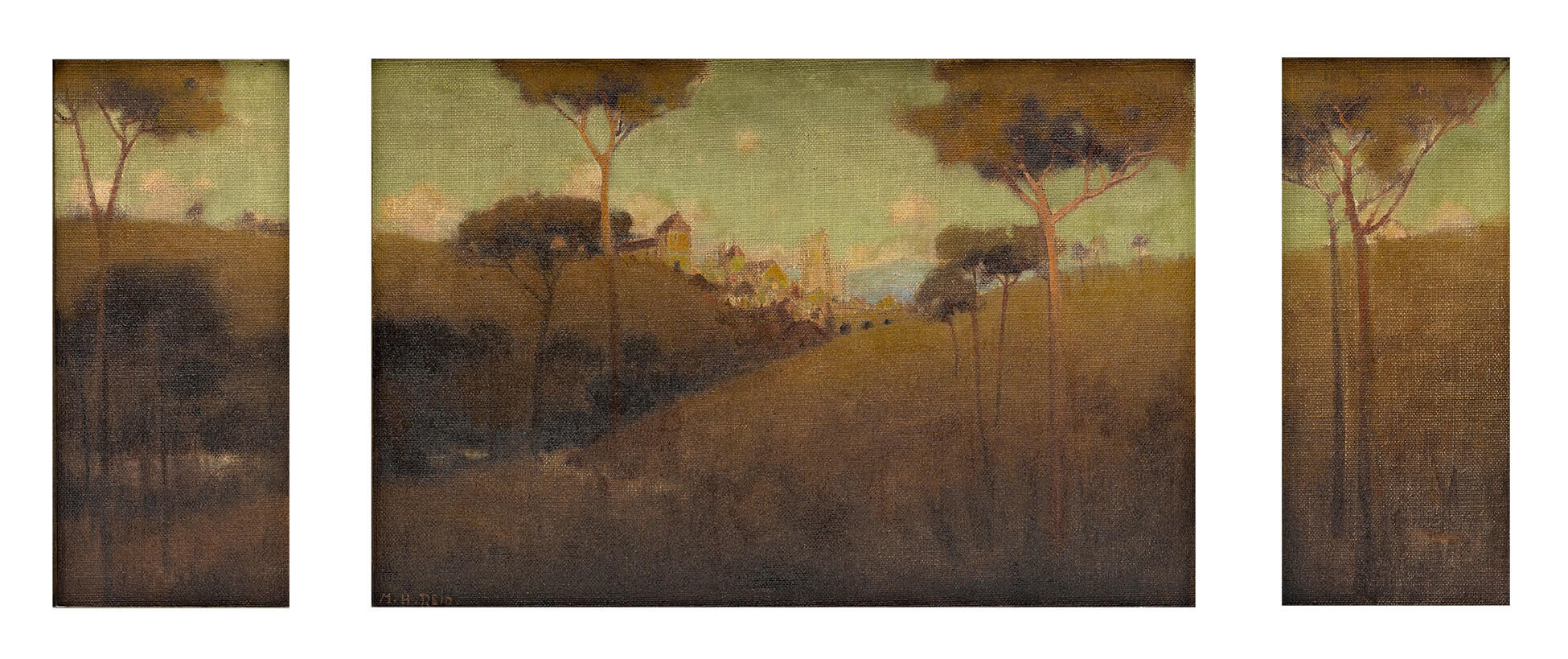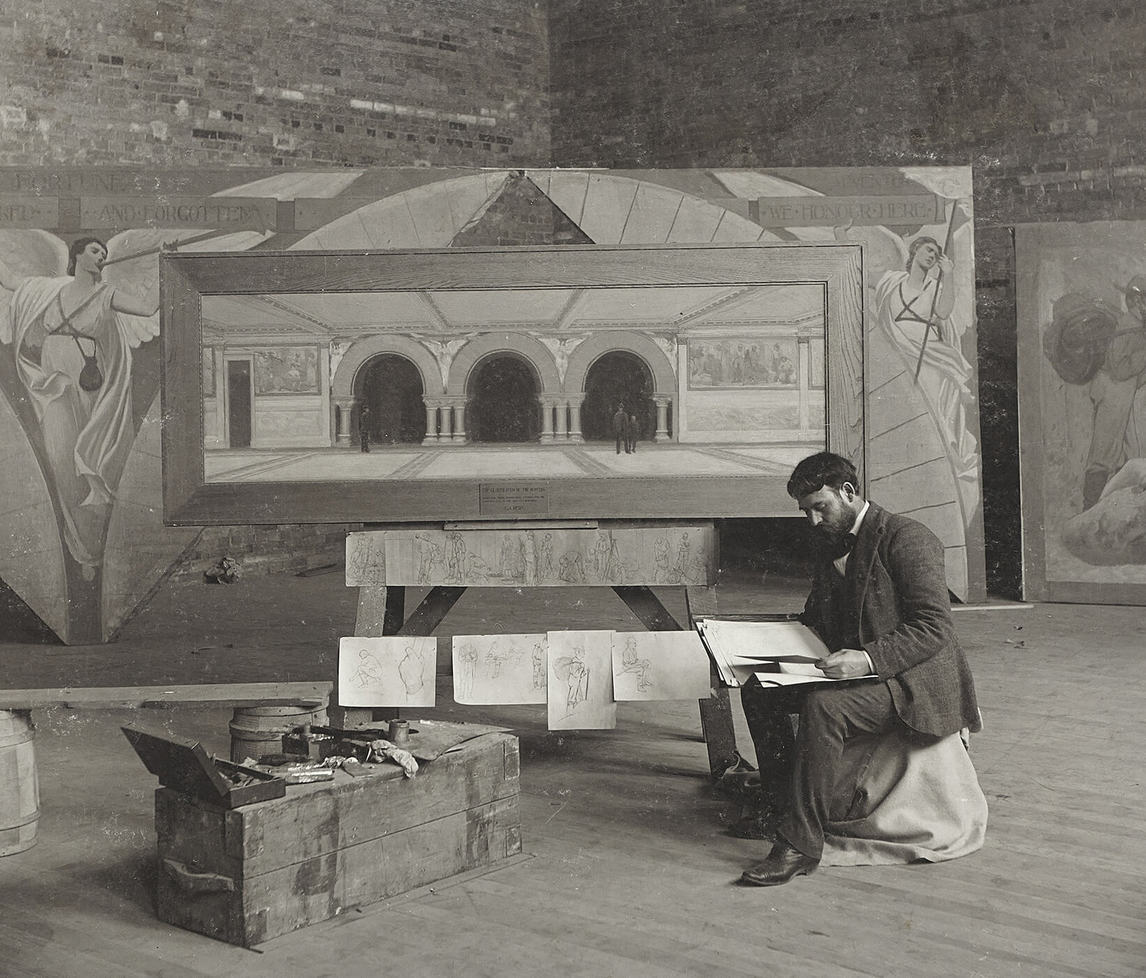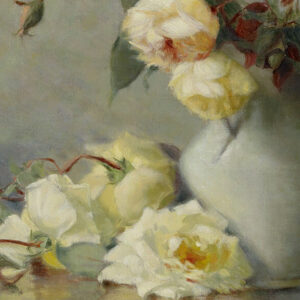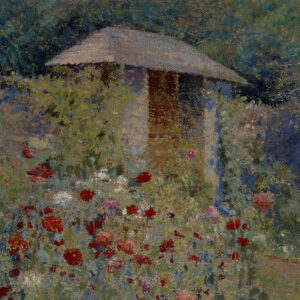Castles in Spain c.1896

Mary Hiester Reid, Castles in Spain, c.1896
Oil on canvas, 53.7 x 137.8 cm
Art Gallery of Ontario, Toronto
Castles in Spain is one of Hiester Reid’s few known extant murals, and demonstrates an ability to work in large-scale formats. As the title indicates, this work depicts her memories and impressions of a journey through Spain in 1896. The artistic achievements of this work may be why she and George Agnew Reid (1860–1947) hung it in Upland Cottage, their home in Toronto’s Wychwood Park.1

When the Reids travelled to Europe in 1896, they toured through Gibraltar and Spain, a journey that Hiester Reid wrote about in a series of three articles published in Toronto’s Massey’s Magazine.2 In the first article, published in May 1896, Hiester Reid writes of her encounters in Granada, a city in Spain’s southern Andalusia region, and how various inhabitants offered to pose for her and her husband.3 Later she writes, “We found [Granada] delightful in the middle of February, and not too chilly for out-door sketching. Permission to paint is easily obtained, and I know of no other city in Spain where an artist could spend a little time more profitably.”4 Both Hiester Reid and Reid sketched at length over the course of the 1896 tour, something she mentions many times in all three Massey’s Magazine articles. Castles in Spain represents the painted culmination of this sketching.
In this triptych, Hiester Reid successfully portrays three-dimensional space in a grandiose landscape, with decreasing forms achieved through a thin application of paint. Located in the left and right panels, the trees in the foreground appear much larger than those in the middle ground and background of the central panel, and the smallest forms—the ones farthest back in the picture plane, in the work’s centre—are called to the viewer’s attention in the work’s title.5
Mural painting is quite different from easel painting in that murals are typically larger in scale and intended to be permanently affixed to the wall of an architectural structure, such as a civic, commercial, religious, or private building. The subject matter usually relates to the purpose of the architecture to which it is affixed.6 This particular work signals the engagement of the Reids with the Arts and Crafts movement in Canada: Upland Cottage, in which it hung, is an Arts and Crafts–style home. George Reid painted several murals, including those found in Jarvis Collegiate Institute (1929–30), and the Royal Ontario Museum (1935–38), both located in Toronto. He was also a founding member of the Society of Mural Decorators established in 1894. Reid’s work in mural decoration stemmed from his interest in William Morris (1834–1896), one of the main proponents of the British Arts and Crafts movement, who argued that architecture was central to art. Thus, all elements of a building should be designed so that the entire complex might function as a complete work of art.

George Reid became vice-president of the Arts and Crafts Society in Canada, founded in Toronto in 1902. In the society’s first few exhibitions he combined his painterly, architectural works with his work in furniture design: in addition to his mural decorations, he showed furniture such as a piano he designed and painted with decorative panels.7 Ultimately, all the murals Reid and Hiester Reid created united both fine and applied art, painting and architecture, a founding principle of the Arts and Crafts movement.
Although George Reid produced murals that are still on display throughout Toronto, such as Hail to the Pioneers, 1887–89, in the Old City Hall (originally the Toronto Municipal Buildings), of the three murals Hiester Reid completed over the course of her career, only Castles in Spain is on display. In 1913 she painted Autumn, originally located in the Town Hall of Weston, Ontario (now part of Toronto), which depicted the local landscape of Humber Valley, but it is now lost.8 She also took on a private mural commission, making Enchanted Castle for Mrs. Agar Adamson of Port Credit, Ontario, which was shown in the 1922 retrospective exhibition. Notably, also in this posthumous exhibition were featured a number of sketches and plans for other mural decorations, labelled in the exhibition catalogue under the heading “Paintings of Mural Decorations—FROM THE STUDIO.”9 Hiester Reid may have planned to do more mural projects but then been unable to complete them for reasons unknown.

 About the Author
About the Author
 More Online Art Books
More Online Art Books
 Acknowledgements
Acknowledgements